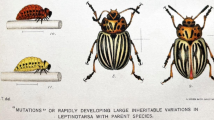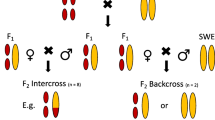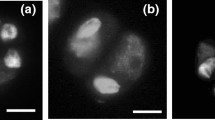Summary
Prior genetic analysis of Oenothera to assess the mechanism(s) controlling differential (biparental) plastid transmission patterns have indicated that the plastome plays an integral role. However, the influence of putative variation in paternal plastid input remains unclear. Pollen collected from Oenothera hookeri plants containing one of four different plastome types (I–IV) in a constant nuclear background (A1A1) was examined cytologically by DAPI/ epifluorescence microscopy. The number of plastid DNA aggregates per pollen generative cell was found to differ significantly. Plants containing plastome types I or II displayed an average of about ten plastid DNA aggregates per generative cell whereas plants containing types III or IV displayed, on average, 15 plastid DNA aggregates. The potential paternal plastid contribution to the egg cell at syngamy (III=IV>I=II) differs from the previously determined survival frequencies of the same four plastid types (I>III>II>IV) progeny.
Similar content being viewed by others
References
Albert VA, Corriveau JL, Coleman AW (1989) Lindleyana 4:192–214
Baur E (1909) Z Vererbungs 1:330–351
Birky CW Jr, (1983) Science 222:468–475
Chiu W-L, Stubbe W, Sears BB (1988) Curr Gent 13:181–189
Coleman AW, Goff LJ (1985) Stain Technol 60:145–154
Correns C (1909) Z Vererbungsl 1:291–329
Corriveau JL, Coleman AW (1988) Am J Bot 75:1443–1458
Corriveau JL, Goff LJ, Coleman AW (1989a) Curr Genet (accepted)
Corriveau JL, Polans NO, Coleman AW (1989b) Curr Genet 16:47–51
Foster AS, Gifford EM Jr (1974) Comparative morphology of vascular plants. Freeman, San Francisco
Gordon KHJ, Crouse EJ, Bohnert HH, Herrmann RG (1982) Theor Appl Genet 61:373–384
Hagemann R (1979) Stadler Symp 11:91–115
Hagemann R (1981) Acta Soc Bot Pol 50:321–327
McIlvaine TC (1921) J Biol Chem 49:183–186
Meyer B, Stubbe W (1974) Ber Dtsch Bot Ges 87:29–38
Miyamura S, Kuroiwa T, Nagata T (1987) Protoplasma 141:149–159
Schötz F (1954) Planta 43:182–240
Schötz F (1958) Planta 51:173–185
Schötz F (1968) Biol Zentralbl 87:33–61
Schötz F (1974) Biol Zentralbl 93:41–64
Schötz F (1975) Biol Zentralbl 94:17–26
Sears BB (1980) Plasmid 4:233–255
Smith SE (1988) Plant Breed Rev 6:361–393
Smith SE (1989) J Hered 80:214–217
Stubbe W (1959) Z Vererbungsl 90:288–298
Tilney-Bassett RAE (1978) The inheritance and genetic behavior of plastids. In: Kirk JTO, Tilney-Bassett RAE (eds) The plastids. Elsevier/North Holland, Amsterdam, pp 251–524
Tilney-Bassett RAE, Abdel-Wahab OAL (1979) In: British Society for Developmental Biology Symposium, vol 4. Cambridge University Press, pp 29–45
Author information
Authors and Affiliations
Additional information
Communicated by Barbara B. Sears
Scientific article no. A-5036, contribution no. 8084 of the Maryland Agricultural Experimental Station
Rights and permissions
About this article
Cite this article
Corriveau, J.L., Coleman, A.W. Plastid inheritance in Oenothera: paternal input may influence transmission patterns. Curr Genet 17, 327–330 (1990). https://doi.org/10.1007/BF00314880
Received:
Issue Date:
DOI: https://doi.org/10.1007/BF00314880




